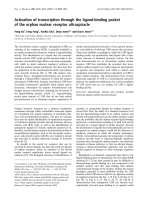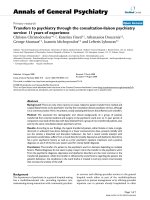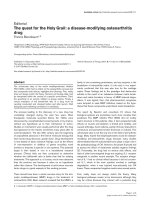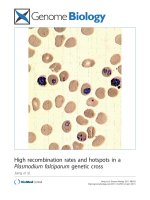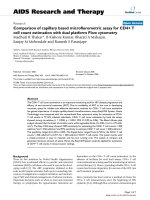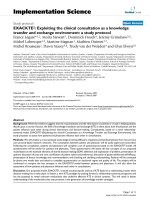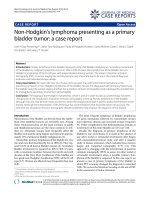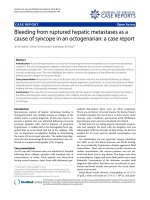Báo cáo y học: "Stochasticity of flow through microcirculation as a regulator of oxygen delivery" doc
Bạn đang xem bản rút gọn của tài liệu. Xem và tải ngay bản đầy đủ của tài liệu tại đây (305.14 KB, 5 trang )
RESEA R C H Open Access
Stochasticity of flow through microcirculation as
a regulator of oxygen delivery
Viktor V Kislukhin
Correspondence: victor.
Transonic Systems Inc, Ithaca, NY,
USA
Abstract
Objective: Observations of microcirculation reveal that the blood flow is subject to
interruptions and resumptions. Accepting that blood randomly stops and resumes,
one can show that the randomness could be a powerful means to match oxygen
delivery with oxygen demand.
Method: The ability of the randomness to regulate oxygen delivery is based on two
suppositions: (a) the probability for flow to stop does not depend on the time of
uninterrupted flow, thus the number of interruptions of flow follows a Poisson
distribution; (b) the probability to resume the flow does not depend on the time for
flow being interrupted; meaning that time spent by erythrocytes at rest follows an
exponential distribution. Thus the distribution of the time to pass an organ is a
compound Poisson distribution. The Laplace transform of the given distribution gives
the fraction of oxygen that passes the organ.
Result: Oxygen delivery to the tissues directly depends on characteristics of the
irregularity of the flow through microcirculation.
Conclusion: By variation of vasomotion activity it is possible to change delivery of
oxygen to a tissue by up to 8 times.
Introduction
The irregular pattern of blood flow through the microcirculation has been described for
all organs and tissues of the body [1]. Estimations of the irregularity of flow by the spec-
tral analysis of a Laser-Doppler signal established that low level of fluctuations in flow is
a sign of the pathology [2], particularly of the low level of oxygen consumption [3].
We hypothesized that the consideration of irregularities as a stochastic process
reveals the ability of randomness be a regulator of oxygen delivery. The aim of the
paper is to test this hypothesis. To reveal the ability of vasomotion to be a regulator of
oxygen delivery we start with two well-established facts (a) any organ at rest has only a
fraction of microvessels perfused [4], (b) there are about a hundred agents influencing
the vasomotor fibers when changing flow from a total stop to a maximum. As a conse-
quence, we can assume that the state of microvessels (open or close) is governed by
random causes (a summation of all influences). If a stochastic approach is accepted,
then it is reasonable to start with a model based on the assumption that the state of
the microvessels depends on the current influences and not previous effects, mathema-
tically speaking, we accept a markovian property for the microvascular system). Main
Kislukhin Theoretical Biology and Medical Modelling 2010, 7:29
/>© 2010 Kislukhin; licensee BioMed Cen tral Ltd. This is an Open Access article distributed under the terms of the Creative Co mmons
Attribution License ( which perm its unrestricted use, distribution, and reproduction in
any medium, provided the original work is properly cited.
result of the paper can be formulated as follows the less b lood flow t hrough an organ,
the more effective vasomotion regulation could be.
Stochastic description of microcirculation
We start with the simple stochastic model: Let T be the time needed for any erythro-
cytes (RBC) to pass an organ if the RBC is in the move, and T is constant for given
organ. The total time to pass an organ by a RBC will be denoted as t, and t - T is the
time spent in the interruptions of flow. To find the t let assume that a probability of
flow to stop does not depend on the time of uninterrupted flow. Given assumption
leads to a Poisson distribution of the number of the interruptions of fl ow [5] with
probability to have, during time T, n interruptions (p
n
) given by:
pT
T
n
n
n
=−exp( )
()
!
β
β
(2:1)
where b is the measure of the intensity of the interruption, and b equals to the mean
number of interruptions during 1 sec.
Let also assume that the probability to resume the flow does not depend on the time
for the flow being interrupted; meaning that the time τ to resume the flo w (after stop-
ping) follows an exponential distribution [5]:
f
μ
τμ μτ
,
( ) exp( )
1
=⋅ −
(2:2)
where μ is the measure of the intensity to resume the flow and 1/μ is the mean time
for resuming of flow.
Since the time t-T is the time spent in n interruptions of flow, then the sum of n
independent random variables with distribution given by (2.2), has the distribution:
ftT
n
tT
n
n
T
n
μ
μ
μ
,
()
()
()!
exp( ( ))
1
1
1
∗
−=
−
−
−
⋅−−t
(2:3)
Combination of (2.1) and (2.3) leads to the distribution of the time to pass an organ,
P(t):
Pt p f t T e
T
n
e
n
tT e
n
n
n
T
n
T
n
n
() ( )
()
!()!
()
,
=⋅−=+
−
−
∗
=
∞
−− −
∑
μ
ββ
βμ
1
0
1
1
−−−
=
∞
∑
μ()tT
n1
(2:4)
We assume also that the flux of oxygen into tissue, along any microvessels, follows
an equation of first order [6].
dO dt O
22
/,=−λ
(2:5)
with l as the intensity of oxygen consumption. Thus the content of oxygen in blood
drops from 1 to exp(-lt) if the time t is the time of transition along the given path.
Since the time to pass an organ has the distribution (2.4) then fraction of oxygen that
passes the organ is integral of exp(-lt) with respect to P(t):
ptPtdt( ) exp( ) ( )λλ=−
∞
∫
o
(2:6)
Kislukhin Theoretical Biology and Medical Modelling 2010, 7:29
/>Page 2 of 5
One can see in (2.6) Laplace transform of the distribution P(t), and for P (t), as (2. 4),
Laplace transform is well known [5]:
pT( ) expλλ
μβλ
μλ
=−
++
+
⎛
⎝
⎜
⎞
⎠
⎟
⎛
⎝
⎜
⎜
⎞
⎠
⎟
⎟
(2:7)
Estimation of the consumed fraction is given by:
11−=− −
++
+
⎛
⎝
⎜
⎞
⎠
⎟
⎛
⎝
⎜
⎜
⎞
⎠
⎟
⎟
≈
++
+
⎛
⎝
⎜
⎞
⎠
⎟
pTT( ) expλλ
μβλ
μλ
λ
μβλ
μλ
(2:8)
Equation (2.4), and the consequence of (2.4), equatio n (2.8) are obtai ned under sup-
position that capillaries system i s the system of homogenous parallel pathways (time T
is constant). However, this is simplification since we have two additional sources of
heterogeneity of flow, besides interruption-resuming flow. They are (a) the tortuosity
of microvessels, and (b) induced by different causes (local viscosity, tone of vessels,
pressures) the changes of flow in any given capillary with time. As the consequence of
these heterogeneities of flow, the time T to pass microcirculation if no interruptions
happen becomes the variable. If T ha s a distribution {B(T)}, then the randomizati on of
(2.7) by B(T) will transform (2.8) into the equation with T as mean transit time to pass
organ without interruption, T
mean
[5], and the estimation o f the consumed fraction is
given by:
1 −≈
++
+
⎛
⎝
⎜
⎞
⎠
⎟
∫
pTBTdT T
mean
(, )()λλ
μβλ
μλ
(2:8a)
Thus heterogeneity of flow does not exclude the influence parameters of interrup-
tion-resuming on the oxygen consumption.
Result
The (2.8) reveals that both stochastic characteristics, b and μ, are included into the
expression for oxygen consumption. To estimate possible influence of b and μ we
should have the ranges of the variation for all variables of (2.8). It should be noticed
that parameters of interest ( l, b and μ) have the dimension as [sec
-1
] = [Hz].
Let esti mate l, the intensity of oxygen consumption. It is known [7] that 100 ml of
arter ial blood contains approximately 18 ml of oxygen. During the time of one second
the body consumes, on average, 3 ml of oxygen. Thus, for lT the estimation is 3/18 =
0.17, with T about 5 sec (range 2-7 sec) [8] the l is about 0.04 (range 0.02-0.08).
Intensity of irregularities estimated by th e spectrum of vasomotion activity is from 0
to 2 Hz [9] thus the estimation for the range of and is from 0 to 2.
Introduced stochastic chara cteristics of microcirculation determinate also the frac-
tion of open microvessels, n
o
. Under a steady state condition, the fraction of micro-
vessels with interrupted flow should correspond to the fraction of vessels with
resuming flow, or
nt n t
oo
βμΔΔ=−()1
(3:1)
Kislukhin Theoretical Biology and Medical Modelling 2010, 7:29
/>Page 3 of 5
Thus the expected fraction of open microvessels is:
n
o
=+μμβ/( )
(3:2)
For muscles at rest, n
o
isabout0.05-0.1[7],ifn
o
is a constant then one can see
from (2.8) that variation of μ and b from small values to the higher values will vary the
oxygen consumption about 8-fold (from lT to about 8lT).
Discussion
Krogh presented the first mathematical model of oxyge n consumption by muscular tis-
sue [10]. His model is based on homogeneous presentation of microvascular system,
and is known as the Krogh-Erlang cylinder model. Krogh suggested that main mechan-
ism to respond on the increase of the demand of oxygen is the recruitment of micro-
vessels, and thus the increase of blood flow. Homogeneous model of Krogh is the
significant simplification of reality. Direct observations of PO
2
in the blood leaving
capillary system reveal heterogeneity of PO
2
that is impossible for homogeneous flow
[11]. An attempt to introduce heterogeneity into description of microcirculation was
presented by Pittman as he considered the spatial distribution of microvessels to follow
a Poisson distribution [11]. Another approach to introduce heterogeneity of blood flow
was presented by Kendal. He introduced compound Poisson-gamma distribution, simi-
lar to (2.4), and successfully used it for the description of the self-similarity of micro-
circulation structure [12].
Another Krogh’s assumption that recruitment of microvessels is the leading response
of tissue if demand for nutrients is up is well established [4,10], meaning that signifi-
cant part of microvessels for any organ is out of perfusion.
Model presented in given paper is based on two assumptions (a) the interruption and
resuming of flow is Markov process and (b) the probability of more then one interrup-
tion/resuming for short period of time is negligible.
Main result (2.8a) is the observation that about 8 fold variation of the demand of
oxygen can be satisfied without variation of blood flow by only the changes in intensity
of vasomotion. Additionally, the increase of fraction of open microvessels given by (3.2)
is result of two independent stochastic processes. The n
o
could be increased if intensity
of interruption of flow (b)isdown,andalsothen
o
could be increased by increase of
intensity to resume the flow (μ), thus the recruitment of microvessels becomes com-
plex process.
In publications [13-15] was established that the irregularity of flow due to vasomo-
tion, from periodic to stochastic could be a regulator of oxygen consumption. How-
ever, in [13,15] is investigated how oscillation of flow around mean value could
influence oxygen consu mption. Such, poss ible, influence on consumption is not con-
sidered in given paper. Publication [14] is based on unrealistic assumption of homoge-
neous perfusion and discrete time. The application of Laplace transform to the
distribution of the time to pass an organ, presented in given manuscript, reveals the
sensitivity of oxygen consumption to the irregularity of blood flow.
Conclusion
1. Irregularities of blood flow within microcirculation considered as an stochastic
process lead to an compound Poisson distribution for the time to pass an organ.
Kislukhin Theoretical Biology and Medical Modelling 2010, 7:29
/>Page 4 of 5
2. Laplace transform of the time to pass an organ reveals the sensitivity of oxyg en
consumption to the irregularity of blood flow.
3. By variatio n of vasomotion activity it is possible to change delivery of oxygen to
tissue by up to 8 times.
Competing interests
The author declares that they have no competing interests.
Received: 28 April 2010 Accepted: 9 July 2010 Published: 9 July 2010
References
1. Zweifach BW: Functional Behavior of the Microcirculation Springfield, Illinois, U.S.A.: Charles C. Thomas Publisher 1961.
2. Stansberry KB, Shapiro SA, Hill MA, McNitt PM, Meyer MD, Vinik AI: Impaired Peripheral Vasomotion in Diabetes.
Diabetis Care 1996, 19:715-721.
3. Intaglietta M: Arteriolar Vasomotion: Implications for Tissue Ischemia. Blood vessels 1991, 28(Suppl 1):1-7.
4. Zierler K: Indicator dilution methods for measuring blood flow, volume, and other properties of biological systems:
a brief history and memoir. Ann Biomed Eng 2000, 28(8):836-848.
5. Feller W: An Introduction to Probability Theory and Its Applications II New York, London, Sydney, Toronto: John Wiley &
Sons, Inc 1959.
6. Lassen NA, Perl W: Tracer Kinetic Methods in Medical Physiology New York: Raven Press 1978, 138.
7. Guyton AC: Textbook of Medical Physiology Philadelphia: W.B. Saunders Company 1986, 233-349.
8. Honig CR, Feldstein ML, Frierson JL: Capillary lengths, anastomoses, and estimated capillary transit times in skeletal
muscle [abstract]. Am J Physiol 1977, 233(1):H122-H129.
9. Bertuglia S, Colantuoni A, Arnold M, Witte H: Dynamic Coherence Analysis of Vasomotion and Flow Motion in
Skeletal Muscle. Microvasc Res 1996, 52:235-244.
10. Krogh A: The Anatomy and Physiology of Capillaries New York: Hafner Publishing CO 1959, 270-290.
11. Pittman RN: Influence of microvascular architecture on oxygen exchange in skeletal muscle. Microcirculation 1995,
2(1):1-18.
12. Kendal WS: A stochastic model for the self-similar heterogeneity of regional organ blood flow. Proc Natl Acad Sci
USA 2001, 98(3):837-841.
13. Goldman D, Popel AS: A computational study of the effect of vasomotion on oxygen transport from capillary
networks. J Theor Biol 2001, 209(2):189-199.
14. Kislukhin VV: Regulation of oxygen consumption by vasomotion. Math Biosci 2004, 191(1):101-108.
15. Pradhan RK, Chakravarthy VS, Prabhakar A: Effect of chaotic vasomotion in skeletal muscle on tissue oxygenation.
Microvasc Res 2007, 74:51-64.
doi:10.1186/1742-4682-7-29
Cite this article as: Kislukhin: Stochasticity of flow through microcirculation as a regulator of oxygen delivery.
Theoretical Biology and Medical Modelling 2010 7:29.
Submit your next manuscript to BioMed Central
and take full advantage of:
• Convenient online submission
• Thorough peer review
• No space constraints or color figure charges
• Immediate publication on acceptance
• Inclusion in PubMed, CAS, Scopus and Google Scholar
• Research which is freely available for redistribution
Submit your manuscript at
www.biomedcentral.com/submit
Kislukhin Theoretical Biology and Medical Modelling 2010, 7:29
/>Page 5 of 5
